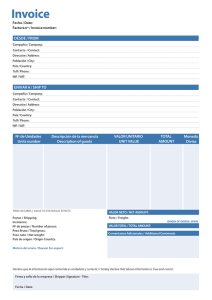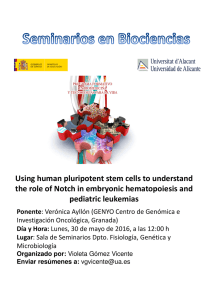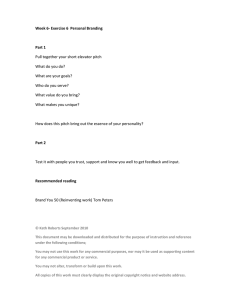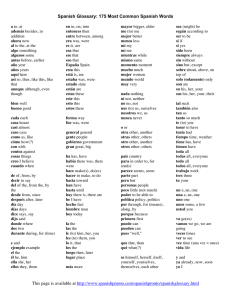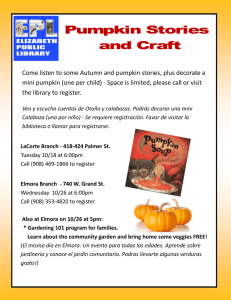Incrementally-build pitch contours and focus structure in Catalan
Anuncio
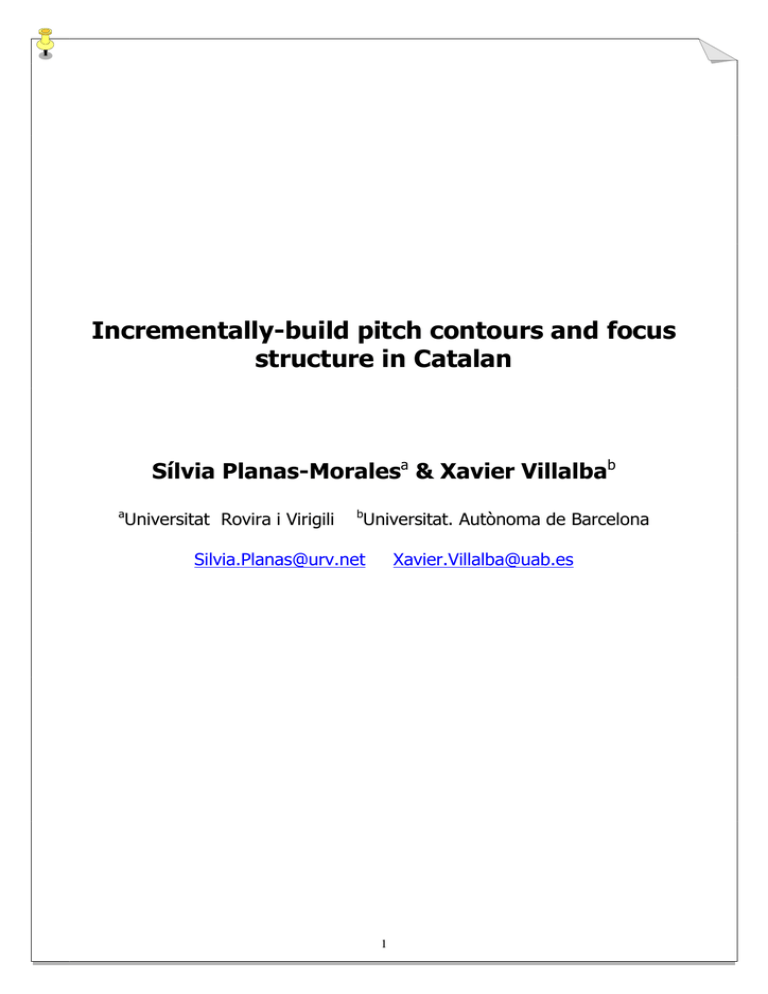
Incrementally-build pitch contours and focus structure in Catalan Sílvia Planas-Moralesa & Xavier Villalbab a Universitat Rovira i Virigili b Universitat. Autònoma de Barcelona [email protected] [email protected] 1 HYPOTHESIS We will defend the hypothesis that the pitch contour of sentences is build on incrementally: Information structure Pitch contour wide focus L*+H on the verb ⇓ ⇓ narrow focus L*+H on the focused item ⇓ ⇓ contrastive focus L*+H on the focused item + increased pitch This proposal will be shown to be empirically well-motivated from a crosslinguistic point of view (Catalan and Spanish being considered), and to offer support to Donati and Nespor’s (2003) hypothesis concerning the crucial role of pitch contours as primary evidence for the acquisition of focus structure. 2 METHOD: THE ANALYSIS PitchWorks (Scicon) Pitch Option Pitch Extraction Method: Cepstral (windows length: 45ms; step size: 10ms). Frequency deviation: 50Hz. Tracking threshold: 1-2%. Calculation range: 70Hz- 200/300Hz. Display range: 50Hz-250/350Hz (with 100hz spacing). 05cat L i v ae n v i a(r) una m a d a words l e n a l A n(n) a 250 150 Hz ms 350 700 1050 1400 1750 We use the spectrogram for a better mapping of the pitch peaks onto the spoken utterance. 3 METHOD: PRODUCTION Catalan corpus 1. context: ‘What happened?’ wide focus: F[La Maria li va enviar una magdalena a l’Anna] ‘Maria sent a cake to Anna’ 2. context: Què va fer la Maria? ‘What did Maria do?’ wide focus: La Maria F[va enviar una magdalena a l’Anna] ‘Maria sent a cake to Anna’ 3. context: Què li va enviar a l’Anna? ‘What did she send to Anna?’ narrow focus short constituent: Li va enviar F[una magdalena] ‘She sent Anna a cake’ 4. context: Què li va enviar a l’Anna? ‘What did she send to Anna?’ narrow focus short constituent: Li va enviar F[una magdalena de crema anglesa] ‘She sent Anna a cream cake’ 5. context: A qui li va enviar una magdalena? ‘Whom did she send a cake to?’ narrow focus short constituent: La Maria li va enviar una magdalena F[a l’Anna] ‘She sent a cake to Anna’ 6. context: Li va enviar un pastís? ‘Did she send her a pie?’ contrastive focus: No. Li va enviar F[una magdalena] ‘No. She sent her a cake’ 7. context: Li va enviar la magdalena a l’Ignasi? ‘Did she send the cake to Ignasi?’ contrastive focus: No. L’hi va enviar F[a l’Anna] ‘No. She sent it to Anna’ 8. context: Li va enviar un pastís a l’Ignasi? ‘Did she send a pie to Ignasi?’ contrastive focus: No. Li va enviar F[una magdalena a l’Anna] ‘No. She sent a cake to Anna’ 9. context: Què va passar? ‘What happened?’ wide focus: F[Va arribar una magdalena] ‘There arrived a cake’ 10. context: Què va arribar? ‘What arrived?’ narrow focus short constituent: Va arribar F[una magdalena] ‘There arrived a cake’ 11. context: Què va arribar? ‘What arrived?’ narrow focus long constituent: Va arribar F[una magdalena de crema anglesa] ‘There arrived a cream cake’ 12. context: Va arribar un pastís? ‘Did a pie arrive?’ contrastive focus: No. Va arribar F[una magdalena] ‘No. There arrived a cake’ Equivalent contexts and sentences for the Spanish corpus. 5 + 5 informants. 4 RESULTS (1) Informative wide focus (09cat) vs. informative narrow focus (10cat) 09cat Què va passar? words v a rr i b a(r)un a m a d a l e n a 250 150 Hz ms 350 700 1050 1400 1750 10cat Què va arribar? words v a rr i b a(r) u n a m a d a l e n a 250 150 Hz ms 400 800 1200 1600 2000 Wide focus is associated with the typical lowering contour of declaratives (i.e. L*+H on the verb plus a continued fall L* and L%), whereas narrow focus is characterized by a significant pitch peak associated with the focused constituent, but, crucially, not with the stressed syllable (i.e. L*+H), plus a continued fall L* and L%. 5 RESULTS (2) Short narrow focus (03cat) vs. long narrow focus (04cat) 03cat Què li va enviar a l'Anna? words L i v ae n v ia(r)unam a d a l e n a 250 150 Hz ms 450 900 1350 1800 2250 04cat L i v a e n v i a(r)una m a d a l e n a d e c r e m a n g l words e s a 250 150 Hz ms 400 800 1200 1600 2000 Again, narrow focus of a short constituent is characterized by a significant pitch peak associated with the focused constituent, but, crucially, not with the stressed syllable (i.e. L*+H), plus a continued fall L* and L%. In contrast, when the focus constituent increases its size, in addition to the initial focus peak, the basic focus tone L*+H is placed on the following stressed syllables, with a decreasing F0 value, unless the last one, which receives the typical L* tone of declaratives. 6 RESULTS (3) Contrast between informative narrow focus (10cas) and contrastive focus (12cas) 10cas ¿Qué llegó? words Ll e g ó un a m a d a l e n a 250 150 Hz ms 300 600 900 1200 1500 12cas ¿Llegó un pastel? words N o # Ll e g óu n a m a d a l e n a 250 150 Hz ms 500 1000 1500 2000 2500 The pitch contour of contrastive focus is build on that of informative narrow focus (i.e. L*+H), with a sharp F0 increase (around 35Hz). 7 DISCUSSION 1) The initial hypothesis is confirmed that the more complex the informative function of focus the more complex its pitch structure. 2) The basic tone of focus in Catalan and Spanish is L*+H. 3) The design of the sentences should take into account proper topic-focus structure within a context. 4) This hypothesis opens the way for an “acquirer-friendly” theory of focus mapping: the children is exposed to increasing phonetic complexity, in agreement with recent proposals, like Donati & Nespor (2003). FURTHER WORK (IN PROGRESS) Interactive controlled method for data elicitation: a Game-Based Conversation Task (based on Schafer, Speer, and Warren, 2004): directed spontaneous speech perception test 8 APPENDIX The role of stress clash A) [What did you buy?] He comprat F[un llibre] (2) he comprat [un llibre] 'He words com 'p ra t [ un 'll i b r e ] 250 150 Hz ms 400 800 1200 1600 2000 B) [What did you buy?] He comprat F[un llibre de matemàtiques] (03) un llibre de matemàtiques 'He c om'pra t[un 'll i br e d e m a t e 'm a t i qu e words s ] 250 150 Hz ms 550 1100 1650 2200 2750 In the A case a typical L*+H focus tone occurs at the beginning of the focus constituent, plus a typical L* and L%. However, in the B case, the L*+H focus tone appears displaced from the very beginning of the focus constituent, against our previous description. This ‘displacement’, however, is an epiphenomenon, for the expected pattern (L*+H at the beginning of the focus constituent, plus an L*+H on the next stressed vowel) would result in a stress clash. 9 REFERENCES D’Imperio, M. 2003. Tonal structure and pitch targets in Italian focus constituents. Catalan Journal of Linguistics 2: 55-66. Donati, C.; Nespor, M. 2003. From focus to syntax. Lingua 113: 1119-1142. Schafer, A.; Speer, S.; Warren, P. 2004. Prosodic influences on the production and comprehension of syntactic ambiguity in a game-based conversation task. In: Trueswell, J.; Tanenhaus, M. eds. Approaches to Studying World-Situated Language Use. Cambridge, Mass.: MIT Press. 209-225. 10
